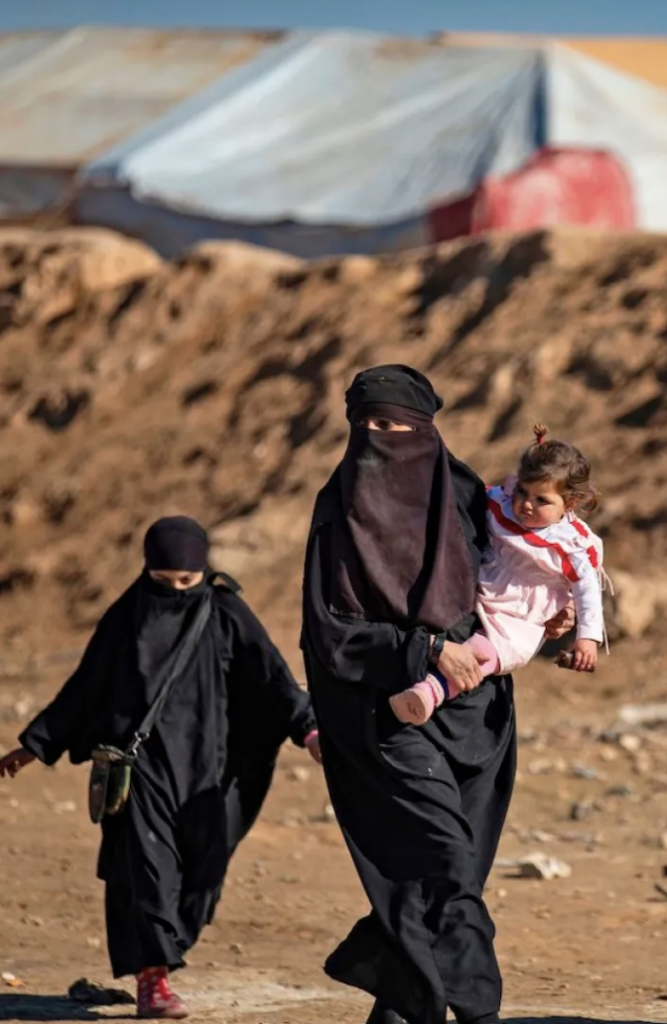WOMEN AND CHILDREN UNDER ISIS
__________________________________________________________________
By Manjiri Phansalkar
ABSTRACT
ISIS, also known as ISIL – the Islamic State of Iraq and the Levant (terrorist organisation) is a Sunni jihadist group with a particularly violent ideology that calls itself a caliphate and claims religious authority over all Muslims. With the quantum of attacks, incidents and undercover – sleeper cells persisting in the transient nexus of the twenty-first century, a very striking component of such an organisation is known to bear great repercussions as well as contribute significantly to its working. Women and children – generally considered to be the ‘softest targets’ in any area of conflict, are subjected to excessive torture and are awarded unforeseen, dreadful consequences on committing an apparent act of crime, which is deemed to be against the rules as dictated by their extremist law. It is such an unbecoming setting that calls for the long – due synthesis and analysis of the treatment offered to women and children under ISIS. This paper looks at three prime areas of detailed study, encountering the framework and mechanisms of ISIS, followed by the extremities experienced by women and children and finally a constructive analysis of the atrocities.
__________________________________________________________________
INTRODUCTION
ISIS is short for the Islamic State of Iraq and Syria and is concurrently also known as ISIL or the Islamic State of Iraq and the Levant. Towards June 2014, ISIS chose to rename itself as the “Islamic State” accounting to the fact that it proclaimed the creation of a global caliphate. Abu Bakr al-Baghdadi, who was their leader since 2010, declared that he was the new caliph and, resultantly, was now ruling all Muslims. ISIS, ISIL and IS appear to be mostly synonymous, however, in the particular case of ISIS, it has been long established that Abu Musab al-Zaqawi was the (extremist) founder of this organisation – in 1999 Within the next five years, al-Zarqawi’s new group rapidly advanced in their recognition through their barbaric activities and simultaneously also chose to associate with Osama bin Laden and Al-Qaeda (AQI). They are known to and considered to be Islamic extremists, Islamists or Jihadists, closely linked to the dramatically popularised concept of Jihad or “struggle.” Various other terrorist organisations, such as the Taliban, Boko Haram, the Al-Qaeda, Hamas and Hezbollah have also been participating in the global realm of affairs and have been making the news for decades(especially now, considering the ongoing Israeli war in Gaza). However, ISIS appears to be in a strata of its own. In 2014, Al-Qaeda officially dissociated itself from ISIS, and subsequently became a self-sustained entity. Al-Qaeda refused to take responsibility for ISIS’ actions which they deemed to be “too extreme” in some cases. ISIS has proven to be a rather negatively growing potential in the acts of terror across the expanse of the globe, considering which, it has now become a force to be reckoned with.
Women and children have always been a significant catalyst in events throughout history. In the case of women, it can be observed that women take various roles for the recruitment, and in that sense become agents for a shift towards radicalization and counter-extremism (Saltman, 2019). Women are the silent driving forces of society. Their involvements and dynamics directly impact the children of the society. Children are seen as the beacon to carrying such radicalised and extremist views forward for society. Focusing particularly on minors, adolescents, it is understood that they are indoctrinated for future jihad, emphasising the influential role that children can also play in terrorist operations (Spencer, 2016) . In this chapter, we attempt to analyse these roles and their impacts in current incidents, in relation to ISIS operations.
DECODING : WOMEN AND CHILDREN UNDER ISIS
While ISIS poses threats to the world in many ways that are manifested through unexpected scenarios, it is noticeable that not all of it is possible without the necessary requirement of manpower, which would / does essentially engage in acts of terror, in the name of an extremist-jihadist law. Although, from time immemorial, society has known itself to be patriarchal by nature, a similar algorithm applies to the mechanisms of ISIS as well. However, a surprising fact represents itself in the form of participation by women and children in acts of terror across the globe. Considering the popular opinion of women being the suppressed fraction of population under the ISIS, it is rather unlikely to witness women (and children) participation alongside men. Two reasons may be considered here. As a first, women may be subjected to forced participation, as a mandate enforced by the patriarchal guidance of laws, or perhaps they do so willingly, out of their personal choice. On the other hand, in the case of children, it is understandable that – a provocative environment- such as that of ISIS would demand only so much from a child so as to follow the traditions long-established by their forefathers, while also keeping in mind the fact that the children from those women who themselves indulge heinous acts of terror, are bound to bring their children up in a manner similar to theirs. In this section of examining the activities and treatment offered to women and children under the ISIS, a synthesis is observed through a framework of three sequential categories. Primarily, we dive into the ideology that ISIS aims to propagate, followed by the understanding of the linkage as established by the ISIS with women and children and finally produce a simple analysis of the established linkage.
- ISIS – WHEREABOUTS
ISIS follows a very extreme form of Islam known as Salafism (in Arabic al salaf al salih means the “pious forefathers”). It promotes violence and bloodshed to establish and maintain Qur’anic hegemony through a very strict adherence to the Qur’an and Shari’a law. ISIS adheres to an apocalyptic theology and believes that the Mhadi or “guided one” will soon arrive and redeem Islam. ISIS has declared jihad against all infidels. That includes westerners, Christians and Jews. But it also includes any other “Muslims” who do not pledge allegiance to Abu Bakr al-Baghdadi as the new caliph, such as Hamas.
- ISIS LINKAGES WITH WOMEN AND CHILDREN
Now arriving at the core question of the origin, and how women and consequently children acquire the roles that they assume in such groups and operations. It is indeed, a vicious cycle of patriarchal beliefs. The women in these societies are not given the opportunity to learn beyond the sustenance of patriarchal beliefs. They are solely made to believe their role is isolated to reproduction, obedience and homely domestic roles. The same psychological thought instilled inside the child’s mind at a very young age, where boys are groomed to be future fighters perpetuating male dominance and young girls are taught to be “homely”, obedient and docile (Makanda, 2019). However, by digging deeper into these roles, we understand that their involvements and impacts are not specific to just the social roles. Women have roles that go beyond their identities as a wife or a daughter of a man. As mentioned before, women have always been a force of assistance in any operation and incident throughout time. Their silent contributions are often gone unnoticed, and not taking the factor of women’s influences, will lead us to viewing an incomplete picture. In operation based jihadi organizations, women are not just “jihadi brides”, their roles traverse through diverse activities, including logistics, suicide bombing, message delivery and at times include, combatant roles. The task of raising future jihadists also falls into the purview of the woman’s role. (Doost, 2011)
Consider a particular situation of the wives of ISIS members residing in the al-Hol camp in the city of Haska in Syria. Their participation, albeit conducted behind closed doors and rather discreetly, have two prime methods, which are known to have greatly benefited the activities of ISIS. The first method stands by the postulates of the ‘expansionist ideology’ as dictated by the extremist-jihadist law. It is of particular importance that exercising the expansionist ideology presents itself as a rather active weapon in allowing the members to succeed in their goals of terrorist intentions, given the quantum of manpower made available to them. The second and most popularly advertised mechanism is exhibited in the form of employing social media as a means to gain sympathy (primarily), propagating the strengths and beliefs of their extremist – jihadist law (secondarily) and finally procuring funds through malicious interactions with other women and people across the globe and supplying the profits to the organisations to support its terror activities.
Shifting focus to the role of children and the impact-effect causality of residing in a radical environment such as that of the ISIS, with specific focus on the al-Hol camp, children are influenced by the women (predominantly mothers), and mature to exhibit an extremely powerful role in society. In the considered scenario, noticeable are three prime methodologies that come about to be exercised. As a primary role of the mothers, with regards to the 28000 children born to the ISIS members, they indulge in nurturing them with the basic Quranic principles. However, another important fact is that, most of the children are not offered formal education or even the basic necessities of healthcare. This, invariably leads to the secondary factor of child indoctrination, whereby the children of the ISIS members are taught brutal interpretation of Islamic texts. Further, in order to identify themselves as true and dedicated members of ISIS, the ‘cubs’ are also taught how to carry out beheadings using dolls, and even employ them to practise their skills in carrying out killings of captives in propaganda videos. The tertiary factor that quite potentially supports the core ideal of Islamic extremist – jihadism is manifested in terms of the reversed manifestation of the ‘expansionist ideology’. Herein, teenage members – children of ISIS indulge in early marriages, with the sole aim of producing more children, who would perforce, be loyal to the terror organisation. The roles that a child assumes as part of terrorist operations like ISIS are hardly talked about. Their actions are villainized and, most often, the fact that they are minors is forgotten. Their struggles and the trauma that is followed in their cases is in general, overlooked. Those minors recruited by ISIS face loss of childhood, exposure to extreme violence, and manipulation through propaganda videos, depriving them of the innocence of childhood while being subjected to mass indoctrination (Khoo & Brown, 2021).
- ANALYSING THE FINDINGS
As represented earlier, in any given conflict, women and children are generally considered to be the softest targets in order to potentially weaken the enemy. Considering the ongoing war of Israel and Gaza, there was an intimation to the Israeli army by the terrorist group Hamas stating the repercussions of prolonged attacks on the captured women officers. Surprising as it may be, that is the ugly reality of war, conflict and disharmony. However, as established earlier, the ISIS deems itself to be in an incomparable league, whereupon the effects of brutal radicalisation of innocent women and children has brought them greater strength on the global sphere as well as called for the face of a fearful entity. The methodologies of expansionist ideals, indoctrination, radicalisation, and other heinous acts in tandem with the extremist jihadist law, have enforced the formation of a rather barbaric armed institution, the curbing of whose actions is exponentially becoming a tedious task.
CONCLUSION
It is thus integral to understand in depth, the roles, the consequent impact and the constant struggles which bind the society in a vicious cycle of recruitment of women and children and the resulting destruction caused by their involvements. There is still limited literature on women’s role in ISIS, something which requires a lot more focus to have a “larger picture” insight into the terrorist operations. Needless to say, it is important to take into consideration the motivations triggering the women and children to be involved in terrorism. It calls for a need to get a grasp of their psyche as a window to create sustainable preventive measures against female and minor radicalization.
BIBLIOGRAPHY
- A caliphate (Arabic: خِلافة khilāfa) is a form of Islamic government led by a caliph (Arabic: خَليفة khalīfah –– a person considered a political and religious successor to the prophet, Muhammad and a leader of the entire Muslim community. en.wikipedia.org/wiki/Caliphate
- A Brief History of ISIS. (2019, February 27). Chosen People Ministries. https://www.chosenpeople.com/ministry-news-brief-history-isis/
- Erin, Marie, Saltman. (2019). Western Female Migrants to ISIS: Propaganda, Radicalisation, and Recruitment. doi: 10.4018/978-1-5225-0156-5.CH010
- Amanda, N., Spencer. (2016). The Hidden Face of Terrorism: An Analysis of the Women in Islamic State. Journal of Strategic Security, doi: 10.5038/1944-0472.9.3.1549
- Joseph, Makanda. (2019). The jihad feminist dynamics of terrorism and subordination of women in the ISIS. doi: 10.17583/GENEROS.2019.3814
- Hamoon, Khelghat-Doost. (2021). Women in Operation-Based Jihadi Organizations. doi: 10.1007/978-3-030-59388-9_5
- The Women of ISIS and the Al-Hol Camp. (n.d.). The Washington Institute. https://www.washingtoninstitute.org/policy-analysis/women-isis-and-al-hol-camp
- Ibid
- Flora, Khoo., William, J., Brown. (2021). Innocence killed: Role of propaganda videos in the recruitment of children of the Islamic State of Iraq and Syria. The Journal of International Communication, doi: 10.1080/13216597.2021.1879203





